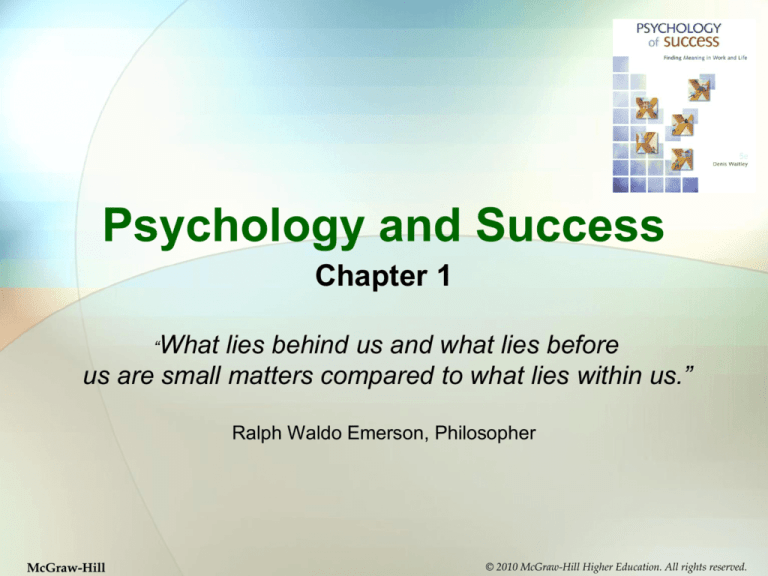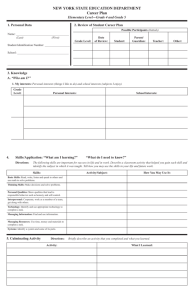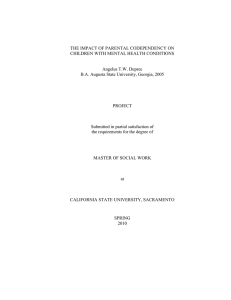
Psychology and Success
Chapter 1
“What
lies behind us and what lies before
us are small matters compared to what lies within us.”
Ralph Waldo Emerson, Philosopher
McGraw-Hill
© 2010 McGraw-Hill Higher Education. All rights reserved.
Learning Objectives
• Define success.
• List several personal qualities that help people
to be happy.
• Define psychology and cite its four major
goals.
• Explain the relationship between thoughts,
feelings, and actions.
• Define self, self-image, and identity.
• Describe the components of identity.
1-2
• What do we mean by perspectives?
• Sensation?
• Perception?
1-3
•
PARIS
IN THE
THE SPRINGTIME
1-4
•
BIRD
IN THE
THE HAND
1-5
•
Once
IN A
A LIFETIME
1-6
What did you see there?
1-7
• What is the difference between
sensation and perception?
1-8
What do you see?
1-9
1-10
1-11
1-12
1-13
1-14
1-15
1-16
1-17
1-18
1-19
1-20
1-21
1-22
An Interesting Afterimage
Illusion
1-23
1-24
1-25
1-26
1-27
1-28
1-29
Understanding Psychology
• Psychology Scientific study of human
behavior.
• Behavior Anything that you think, feel or do.
• Goals of Psychology Describe, predict,
explain, and (in some cases) change human
behavior.
Success Secret
• Studying psychology helps you understand
yourself and others.
1-30
Explaining Human Behavior
Why do people think, feel and act the way they do?
• Nervous system Regulates thoughts, feelings
and actions.
• Conscious Mind The part of the brain that
controls the mental processes of which we are
aware.
• Subconscious Mind The part of the brain that
controls the mental processes of which we are
not actively aware.
1-31
Thoughts, Feelings, and Actions
• Cognition (thought) Mental processing of
information in any form.
• Includes: perceiving, recognizing,
remembering, reasoning, solving problems,
making decisions, forming concepts,
visualizing.
• Emotion (feeling) Subjective feeling
accompanied by physical and behavioral
changes.
Personal Journal 1.2
Your Thoughts, Feelings, and Actions
1-32
Psychology
The science & study of human
behavior…including the underlying
processes that cause behavior…
…both physiological &
mental…
1-33
We study those psychological (mental,
emotional, social) and physiological
processes that underlie human behavior!
Clinical Psychology study focused on
diagnosis and treatment of mental disorders.
Adjustment focuses on adapting to the
changes in one’s environment ,thus the
psychological processes that allow people to
manage and cope within the demands of
everyday life!
1-34
How do we know what
we know?
Research!
Especially
empirical study*
and clinical
observations!
*the scientific method
Wadsworth, Thomson Learning
Hutchens, 2000
1-35
What is an OBSERVATION?
What you measure, see, count, time, etc.
An observation is an event,
even a little one..
What are
VARIABLES ?
CHARACTERISTICS!
Wadsworth, Thomson Learning
1-36
Hutchens, 2000
HOW to understand research?
Look for the
DEPENDENT** & INDEPENDENT
VARIABLES
**What was MEASURED!
1-37
• A TRUE experiment is a research method
where one variable (IV) is manipulated to
see if there is a change in another variable
(DV).
• The independent variable is the thing that
someone actively controls/changes; while
the dependent variable is the thing that
changes as a result. In other words, the
independent variable is the “presumed
cause,” while dependent variable is the
“presumed effect” of the independent
variable.
1-38
What is Success?
Success: a lifetime of personal fulfillment.
Success Secrets
• Success is a journey, not a destination.
• Money and fame don’t equal success.
Activity 1: What Success Means to You
1-39
Ingredients of Success
1. Self-Awareness Appreciating your personal
values, qualities, skills and interests.
2. Self-Direction Setting a goal and working
toward it.
3. Self-Esteem Respecting oneself.
4. Positive Thinking Focusing on future
possibilities to propel yourself toward your
goals.
1-40
Ingredients of Success continued…
5. Self-Discipline Daily personal effort
putting your plans into action.
6. Self-Motivation Getting and staying
motivated. Moving forward despite
fears.
7. Positive Relationships Healthy
relationships with friends, family, and
co-workers.
Personal Journal 1.1 Ingredients of Success
1-41
Who is a Success?
• In society, it is not always obvious who are
truly successful people.
• Role Model Person who has qualities you
would like to have.
Success Secrets
• Always make time for relationships.
• Adults need role models, too.
Activity 2: Role Model
1-42
Neobehaviorism
AKA
Social Learning Theory
Proponent – Albert Bandura
Do you know the “Bobo study”?
Observational learning occurs
vicariously,
“watch and learn…”
1-43
Social Learning Theory
• 2 Processes:
• IMITATION &
OBSERVATION
• Modeling
• Increased by the degree to which the observer
can identify with the model
• What does that mean for the
MEDIA , SPORTS
figures, etc.
• models?
Wadsworth, Thomson Learning
1-44
Hutchens, 2000
Personality includes
Self-Efficacy
SOURCES of its development:
1. Outcomes - consequences of your
behavior - “reinforcement!”
2. Vicarious – comparison of YOUR own skills as
compared to others’ (observation?)
3. Persuasion - “Others say that you...”
can?
can’t?
4. Emotive - how you FEEL…”I think I can
I think I can; I think I can …”
1-45
Hutchens,
2000
Social-Learning Theory
• Modeling: The social-learning process
by which behavior is observed and
imitated
• Locus of Control: The expectancy that
one’s reinforcements are generally
controlled by internal or external
factors
• Self-Efficacy: The belief that one is
capable of performing the behaviors
required to produce a desired
outcome.
1-46
Reciprocal Determinism
• Personality emerges
Person factors
from the mutual
(cognitive)
interactions of
individuals, their
actions, and their Overt Behavior
environments
Environmental influences
(Situation)
1-47
CONSEQUENCES
• Reinforcement
That which
increases or
maintains the
frequency of a
behavior.
1-48
Hutchens,
2000
• Punishment
That which
decreases the
frequency of a
behavior.
Success and Happiness
• Happiness The natural experience of
winning your self-respect and the respect of
others.
• Outside factors—wealth, youth, physical
attractiveness, etc., have little effect on
happiness.
Success Secret
• Create your own opportunities for happiness.
Activity 3: How Happy Are You?
1-49
The search?
• Enlightenment programs
• E.g., “est,” Scientology, Silva Mind Control
• Organized groups
• Cult-type ideology
• Dangers apparent in Heaven’s Gate
• Security and belongingness are keys to involvement
• Established Religious Groups
• E.g., Promise Keepers
• Public “counsel”
• E.g., Dear Abby, Dr. Phil, etc.
• Self-improvement strategies
• E.g., self-help media
1-50
Codependency Movement
• Origin: “enabling” aspects of alcoholics’
spouses
• Beattie’s 1987 Codependent No More
• Expanded application of the term
• Identified addictions to diverse behaviors &
• “Codependency” to the participation of significant
others in that “addictive” behavior
• The participation/controlling/enabling, itself, signals
“codependency” in the significant other
• Treatment options include The Twelve-Step
Program of AA
1-51
Is the Codependency Movement
for real?
• Evaluation difficult
• Definitions vary widely
• Empirical research is minimal
• With vague definition, it’s hard…
• Which behaviors would one choose?
• Are all compulsive behaviors addictions?
• Are all repetitive behaviors compulsive?
• What problems are the ones “caused” by
codependency?
• Gender bias
• Over-application to women
• Questions as to the NURTURING ROLE applied more to
women
1-52
The SELF-HELP SENSATION
Books
…become a
Tapes
discriminating
Videos
consumer!
Infomercials
Self-Improvement
plans
1-53
The SELF-HELP Evaluation
• Problems to watch for…
• Psychobabble
• Circular definitions and solutions…become a
discriminating
• Absence of empirical backing
consumer!
• Concrete solutions
• Look for …
• Clarity and soundness
• A plan, not a “miracle cure” or “quick fix”
• Scientific support of effectiveness
1-54
Positive Qualities
• Another way to boost your happiness is to develop
personal qualities that will help you enjoy life and
cope with challenges.
• Psychologists have identified the following qualities:
ability to love, vocation, courage, trust, optimism,
future-mindedness, social skills, aesthetic sensibility,
work ethic, honesty, emotional awareness,
persistence, forgiveness, creative thinking, spirituality,
self-esteem and wisdom.
Success Secret
• Try new ways of thinking and doing.
1-55
Positive and Negative Emotions.
1-56
Understanding Yourself
• Self Your sense of being a unique, conscious
being, the inner core of you.
• Self-Image All the beliefs you have about
yourself.
• Areas in which you have self-images include:
intellectual ability, competence, creativity,
sense of humor, morality, romantic appeal,
physical appearance, parental relationships,
close friendships, and social acceptance.
1-57
Building A Healthy Self-Image
• A healthy self-image is positive but realistic.
• Makes the best of all the things you do well.
• Is based on who you are right now.
• Does not limit who you will be next week.
• A complex self-image means having a variety of
positive ways to see yourself.
Personal Journal 1.3 How Do You See Yourself?
Activity 4: Wheel of Life
1-58
You and Your Social World
• Social Role Norms that define how you are
supposed to behave in a given situation.
• Self-Preservation Altering your behavior to
make a good impression of others.
Activity 5: Sides of Yourself
1-59
Identity
• How you choose to define yourself to the
world.
• Individual Identity The physical and
psychological characteristics that distinguish
you.
• Relational Identity How you identify yourself
in relation to others.
• Collective Identity The sum of the social
roles you play and the social groups to which
you belong.
Activity 6: Identify Profile
1-60
Culture, Gender and Identity
• Culture – the behaviors, ideas, attitudes, and
traditions shared by a large social group,
transmitted from one generation to the next.
Western– individualism, Eastern-collectivism
• Gender Role – norms that define how males
and females are supposed to behave.
• Gender Bias - treating someone differently
or unfairly due to one’s gender.
1-61
Defining Your Role
• Researchers suggest that it is healthiest to
have a combination of stereotypically
masculine and feminine qualities.
• Some typical qualities: logical, assertive,
sensitive, independent, gentle,
compassionate.
Success Secret
• Don’t put limits on what you can become.
1-62






